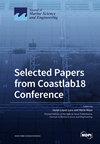近海非常规储层粗糙裂缝中支撑剂的输送机制:页岩和致密砂岩
IF 2.8
3区 地球科学
Q1 ENGINEERING, MARINE
引用次数: 0
摘要
水力压裂后,非常规储层经常会遇到与支撑剂有效支撑距离有限和支撑剂投放不理想有关的挑战。由于海上储层具有很强的异质性,不同的岩性会导致不同的裂缝粗糙度,因此系统地研究粗糙度与支撑剂输送之间的关系可以优化作业参数。本研究采用了分形维度分析的盒维度法,对真实三轴测试产生的自相关高斯分布表面的粗糙度进行量化。结合双向耦合的(计算流体动力学)CFD-DEM(离散元法)数值分析,通过对比验证模拟,获得了不同粗糙度的裂缝内支撑剂沉积和传输过程的规律。结果表明,对于页岩中较粗糙的裂缝,支撑剂的运移距离较远,但在 JRC_52(接缝粗糙度系数)处,弯曲区域可能出现堵塞,存在近井堵塞的风险。与光滑模型相比,JRC_28(致密砂岩)中的波动大大增加了裂缝内的湍流动能,改变了颗粒的输送动力学。此外,由于重力作用,较小的支撑剂(d/w ≤ 0.3)表现出更好的输送能力,但当颗粒太小时,支撑剂的传导性会受到限制。建议使用 0.4 的 d/w,以保证油井附近的输送能力和支撑剂效率。此外,在页岩裂缝中由小到大依次注入支撑剂,可获得最佳支撑效果,并可利用较小支撑剂在粗糙裂缝中较好的输送能力。大颗粒支撑剂(d/w = 0.8)主要靠重力沉积,形成倾斜的砂床,从而确保裂缝的孔隙度。这项研究为裂缝粗糙度对海上非常规储层支撑剂运移的影响提供了一个全新的视角,并为支撑剂注入顺序提供了有价值的考虑因素。本文章由计算机程序翻译,如有差异,请以英文原文为准。
Mechanisms of Proppant Transport in Rough Fractures of Offshore Unconventional Reservoirs: Shale and Tight Sandstone
After hydraulic fracturing, unconventional reservoirs frequently encounter challenges related to limited effective proppant support distance and suboptimal proppant placement. Due to the strong heterogeneity of offshore reservoirs, which causes varying fracture roughnesses depending on different lithologies, a systematic study of the relationship between roughness and proppant transport could optimize operational parameters. This study incorporates the box dimension method for fractal dimension analysis to quantify roughness in auto-correlated Gaussian distributed surfaces created by true triaxial tests. Combined with the numerical analysis of (computational fluid dynamics) CFD-DEM (discrete element method) for bidirectional coupling, the laws of proppant deposition and transport processes within fractures with different roughnesses are obtained through comparative verification simulations. The results show that for rougher fractures of shale, the proppants are transported farther, but at JRC_52, (joint roughness coefficient), where there may be plugging in curved areas, there is a risk of near-well blockages. Compared to the smooth model, fluctuations in JRC_28 (tight sandstone) drastically increase turbulent kinetic energy within the fracture, altering particle transport dynamics. Moreover, smaller proppants (d/w ≤ 0.3) exhibit better transport capacity due to gravity, but the conductivity of the proppant is limited when the particles are too small. A d/w of 0.4 is recommended to guarantee transport capacity and proppant efficiency near the well. Additionally, proppants injected sequentially from small to large in shale fractures offer optimal propping effects, and can take advantage of the better transport capacity of smaller proppants in rough fractures. The large proppant (d/w = 0.8) is primarily deposited by gravity and forms a sloping sand bed, which subsequently ensures the aperture of the fractures. This research provides a fresh perspective on the influence of fracture roughness on proppant transport in offshore unconventional reservoirs and offers valuable considerations for the order of proppant injection.
求助全文
通过发布文献求助,成功后即可免费获取论文全文。
去求助
来源期刊

Journal of Marine Science and Engineering
Engineering-Ocean Engineering
CiteScore
4.40
自引率
20.70%
发文量
1640
审稿时长
18.09 days
期刊介绍:
Journal of Marine Science and Engineering (JMSE; ISSN 2077-1312) is an international, peer-reviewed open access journal which provides an advanced forum for studies related to marine science and engineering. It publishes reviews, research papers and communications. Our aim is to encourage scientists to publish their experimental and theoretical results in as much detail as possible. There is no restriction on the length of the papers. The full experimental details must be provided so that the results can be reproduced. Electronic files and software regarding the full details of the calculation or experimental procedure, if unable to be published in a normal way, can be deposited as supplementary electronic material.
 求助内容:
求助内容: 应助结果提醒方式:
应助结果提醒方式:


